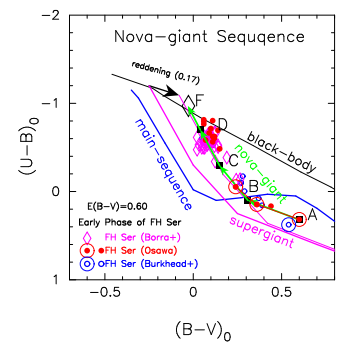 We identified a general course of classical nova outbursts in the B-V versus U-B color-color diagram. It is reported that novae show spectra similar to those of A--F supergiants near optical light maximum. However, they do not follow the supergiant sequence in the color-color diagram, neither the blackbody nor the main-sequence sequence. Instead, we found that novae evolve along a new sequence in the pre-maximum and near-maximum phases, which we call ``the nova-giant sequence.'' This sequence is parallel to but \Delta (U-B) \approx -0.2 mag bluer than the supergiant sequence. This is because the mass of a nova envelope is much (\sim10^{-4} times) less than that of a normal supergiant. After optical maximum, its color quickly evolves back blueward along the same nova-giant sequence and reaches the point of free-free emission (B-V=-0.03, U-B=-0.97), which coincides with the intersection of the blackbody sequence and the nova-giant sequence, and remains there for a while. Then the color evolves leftward (blueward in B-V but almost constant in U-B), owing mainly to the development of strong emission lines. This is the general course of nova outbursts in the color-color diagram, which was deduced from eight well-observed novae in various speed classes. For a nova with unknown extinction, we can determine a reliable value of the color excess by matching the observed track of the target nova with this general course. This is a new and convenient method for obtaining the color excesses of classical novae. Using this method, we redetermined the color excesses of twenty well-observed novae. The obtained color excesses are in reasonable agreement with the previous results, which in turn supports the idea of our general track of nova outbursts.
We identified a general course of classical nova outbursts in the B-V versus U-B color-color diagram. It is reported that novae show spectra similar to those of A--F supergiants near optical light maximum. However, they do not follow the supergiant sequence in the color-color diagram, neither the blackbody nor the main-sequence sequence. Instead, we found that novae evolve along a new sequence in the pre-maximum and near-maximum phases, which we call ``the nova-giant sequence.'' This sequence is parallel to but \Delta (U-B) \approx -0.2 mag bluer than the supergiant sequence. This is because the mass of a nova envelope is much (\sim10^{-4} times) less than that of a normal supergiant. After optical maximum, its color quickly evolves back blueward along the same nova-giant sequence and reaches the point of free-free emission (B-V=-0.03, U-B=-0.97), which coincides with the intersection of the blackbody sequence and the nova-giant sequence, and remains there for a while. Then the color evolves leftward (blueward in B-V but almost constant in U-B), owing mainly to the development of strong emission lines. This is the general course of nova outbursts in the color-color diagram, which was deduced from eight well-observed novae in various speed classes. For a nova with unknown extinction, we can determine a reliable value of the color excess by matching the observed track of the target nova with this general course. This is a new and convenient method for obtaining the color excesses of classical novae. Using this method, we redetermined the color excesses of twenty well-observed novae. The obtained color excesses are in reasonable agreement with the previous results, which in turn supports the idea of our general track of nova outbursts.
Authors: Izumi Hachisu (Univ. of Tokyo), Mariko Kato (Keio Univ.)

